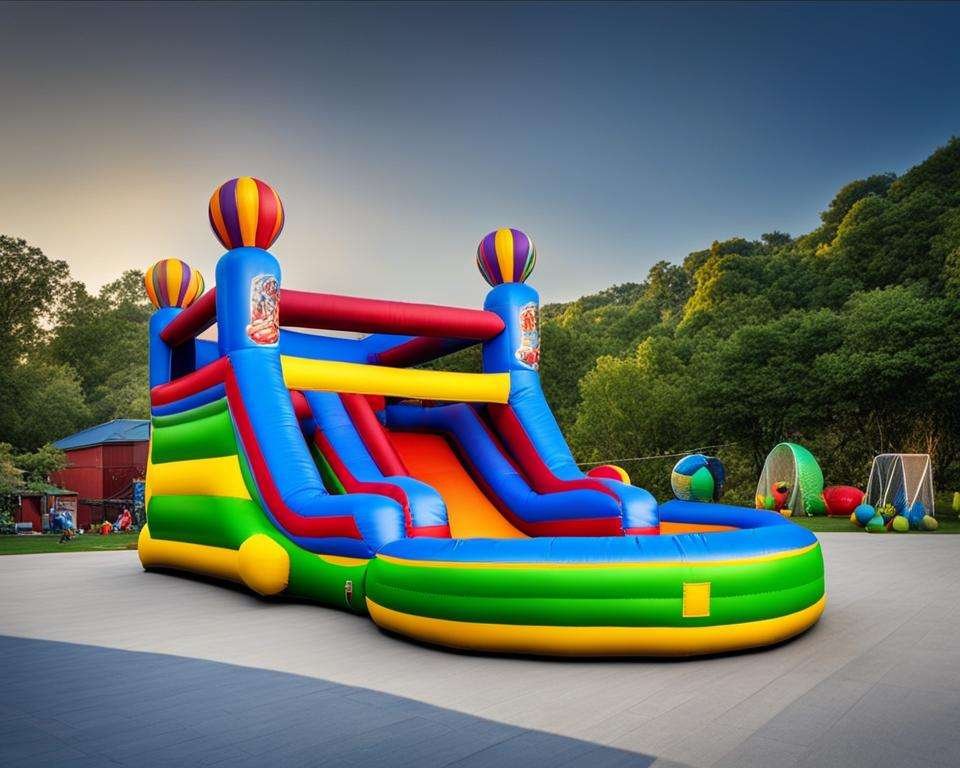Welcome to the fascinating world of inflatable structures! Have you ever wondered, how do inflatables work? How do those gigantic inflatable castles come to life or how inflatable boats stay afloat? In this article, we will look into the inner workings of inflatable technology and explore the secrets behind their design and functionality.
Inflatable structures are ingenious creations that rely on the principles of pneumatic technology. They are composed of an air cavity wall and roof, which are brought to life by a constant supply of air from an integral fan.
Stitching and seams hold together the segments or panels that make up the structure, allowing air to escape through small holes in the stitching. To maintain air pressure, the structure is coated with polyurethane.
Designing inflatable structures is no easy task. Computer simulations are used to create the optimal structure, which is then tested for its functionality and durability. Once the design is finalized, the manufacturing process begins, involving cutting, sewing, and inflation testing.
Key Takeaways
- Inflatable structures work by inflating an air cavity with a constant supply of air.
- Stitching and seams allow air to escape, while polyurethane coating maintains air pressure.
- Computer simulations are used for designing and testing inflatable structures.
- Manufacturing involves cutting, sewing, and inflation testing.
- Inflatables are used in various applications, such as advertising, recreation, and transportation.
Components of Inflatable Structures
Inflatable structures are composed of various components that work together to create a durable and functional design. These components include:
Inflatable Materials
The choice of materials is crucial in ensuring the strength and longevity of inflatable structures. Flame retardant nylon and PVC are commonly used materials, with PVC being preferred for harder-wearing areas that require increased durability.
Internal Ribs
Internal ribs or straps are strategically placed within the inflatable structure to provide shape and structural support. These ribs help maintain the desired form of the inflated structure, ensuring it remains sturdy and reliable.
Stitching
Heavy-duty stitching is employed to join the panels and segments of the inflatable structure. This stitching ensures the different components are securely held together, contributing to the overall durability and strength of the inflatable.
Zips and Velcro
For ease of access and additional strength, zips and Velcro are incorporated into inflatable structures. Zips allow for convenient entry and exit points, while Velcro provides added stability and reinforcement at specific areas of the structure.
The combination of these components in inflatable structures ensures their functionality and longevity. The choice of materials, the presence of internal ribs, the quality of stitching, and the incorporation of zips and Velcro all contribute to the overall reliability and effectiveness of inflatable structures.

Manufacturing Process of Inflatable Structures
When it comes to the manufacturing process of inflatable structures, several key steps are involved in turning a design into a fully functional inflatable. These steps include designing the structure, testing it, plotting and cutting the materials, sewing the panels together, and printing if necessary.
First and foremost, the structure of the inflatable is designed using computer simulation software. This allows for precise measurements and calculations to ensure the structure is both safe and functional. Once the design is finalized, it is put to the test in a computer simulator to simulate real-world conditions and ensure its stability.
After the design and testing phase, the pattern for the inflatable structure is created by collapsing the 3D design into 2D segments. These segments are then plotted and cut out from the chosen materials. The panels are carefully sewn together by hand or machine, using heavy-duty stitching to ensure durability and longevity.
If the inflatable requires any additional graphics or branding, printing is done on the panels before they are cut. This allows for precise placement and ensures that the design is seamless once the panels are joined together. A skilled seamstress then joins the printed panels, creating a cohesive and visually appealing inflatable structure.
Table: Manufacturing Process of Inflatable Structures
| Step | Description |
|---|---|
| Design | Create the structure design using computer simulation software. |
| Testing | Simulate real-world conditions to ensure the stability and functionality of the design. |
| Plot and Cut | Create a pattern by collapsing the 3D design into 2D segments, then plot and cut the panels from the chosen materials. |
| Sewing | Join the panels together using heavy-duty stitching, either by hand or machine. |
| Printing | Add any desired graphics or branding to the panels. |
| Joining | Join the panels together by a skilled seamstress to create a cohesive inflatable structure. |
By following this comprehensive manufacturing process, inflatable structures are created to be both functional and visually appealing. The attention to detail in each step ensures the durability and longevity of the inflatables, allowing them to withstand various conditions and serve their intended purposes.
Types of Inflatables
When it comes to inflatables, there are various types designed to cater to different needs. These types can be broadly categorized into high-pressure inflatables and low-pressure inflatables. Each type has its own unique characteristics and applications.
High-Pressure Inflatables
High-pressure inflatables are known for their structural limbs that are inflated at high pressure. This type of inflatable is commonly used for applications that require greater stability and rigidity. Some examples of high-pressure inflatables include inflatable castles, inflatable boats, and pneumatic tires.
Low-Pressure Inflatables
In contrast, low-pressure inflatables rely completely on internal pressure to hold their shape. These inflatables are often lightweight and flexible, making them suitable for a wide range of applications. Balloons and air-supported structures are examples of low-pressure inflatables that are commonly used for advertising, events, and recreational purposes.
| Type | Examples | Applications |
|---|---|---|
| High-Pressure Inflatables | Inflatable castles, inflatable boats, pneumatic tires | Recreation, transportation |
| Low-Pressure Inflatables | Balloons, air-supported structures | Advertising, events, recreational activities |
Whether you need a high-pressure inflatable for its stability or a low-pressure inflatable for its versatility, there are options available to suit your specific requirements. These inflatables offer an innovative and portable solution for various industries and applications, providing endless possibilities for creativity and functionality.

Sealed Air Inflatables vs. Constant Air Inflatables
When it comes to inflatables, there are two main types to consider: sealed air inflatables and constant air inflatables. Understanding the differences between these two options is crucial in determining which one is best suited for your needs.
The Usability Factor
Sealed air inflatables offer the advantage of portability. Once inflated and sealed, they can be easily transported to different locations. This makes them ideal for events or activities that require frequent setup and teardown. Constant air inflatables, on the other hand, require a continuous power source to keep them inflated. While they may not be as portable as sealed air inflatables, their constant airflow ensures a consistent and reliable structure.
Durability and Design Considerations
When it comes to durability, constant air inflatables have the upper hand. The continuous airflow provides added strength and stability, making them more resistant to wear and tear. This makes them a popular choice for commercial applications that require long-lasting structures. Sealed air inflatables, while not as durable, can still withstand regular use with proper care and maintenance.
When considering the size and design of your inflatable, constant air inflatables offer more flexibility. The constant airflow allows for intricate and detailed designs, making them an excellent choice for eye-catching displays. Sealed air inflatables are better suited for simpler shapes and designs due to their sealing mechanism.
Ease of Setup and Power Source
Setting up sealed air inflatables is relatively straightforward. Once inflated and sealed, they require no additional power source. On the other hand, constant air inflatables need to be connected to a power source to maintain inflation. This means you’ll need access to electricity or a generator to keep them inflated.
| Sealed Air Inflatables | Constant Air Inflatables | |
|---|---|---|
| Usability | Portable, easy setup | Require a power source, less portable |
| Durability | Less durable | More durable and resistant to wear and tear |
| Size and Design | Simpler shapes and designs | Intricate and detailed designs |
| Power Source | No additional power source needed | Require connection to a power source |
Conclusion
So, now you know the ins and outs of how inflatables work! Whether it’s a massive inflatable castle or a small advertising balloon, the basic mechanism remains the same. Inflatables rely on the inflation of air to create their structure and support their function.
There are two main types of inflatables: those that use a sealed air system and those that utilize a constant air system. Sealed air inflatables are easily portable and ideal for carrying around, but they may require additional air throughout the day due to temperature changes. On the other hand, constant air inflatables provide a continuous flow of air, allowing for intricate designs and easy setup, but they do require a power source.
Understanding the working principles and construction process of inflatables gives us a deeper appreciation for their functionality and diverse applications. From advertising to recreation to transportation, inflatables play a significant role in various industries. So, the next time you see an inflatable, you’ll have a better understanding of the incredible mechanism behind it!
FAQ
How do inflatable structures work?
Inflatable structures consist of an air cavity wall and roof that are inflated and supported by a constant supply of air from an integral fan. The structure is made up of segments or panels that are sewn together with stitching and seams. The air between the inner and outer membranes escapes through small holes in the stitching, and the structure is coated with polyurethane to maintain air pressure. Inflatable structures are designed using computer simulation and manufactured through a process of design, testing, cutting, sewing, and inflation testing.
What materials are inflatable structures made from?
Inflatable structures are made from materials such as flame retardant nylon and PVC for harder-wearing areas. Internal ribs or straps help shape the structure, and heavy-duty stitching is used to ensure durability. Zips and Velcro provide access and additional strength to the structure.
What is the manufacturing process of inflatable structures?
The manufacturing process of inflatable structures starts with designing the structure and testing it in a computer simulator. Patterns are made by collapsing the 3D design into 2D segments, which are then plot and cut out. The panels are sewn together by hand or machine, and the structure is tested with inflation equipment. Printing is done before cutting the material, and the printed panels are joined together by a seamstress.
What are the different types of inflatables?
Inflatables can be categorized into high-pressure and low-pressure types. High-pressure inflatables have structural limbs inflated at high pressure, while low-pressure inflatables are completely held up by internal pressure. Balloons, inflatable castles, inflatable boats, pneumatic tires, and air-supported structures are some examples of different types of inflatables.
What are sealed air inflatables and constant air inflatables?
Sealed air inflatables are inflated with a pump and then sealed, making them portable and suitable for carrying around. They are affected by temperature changes and may require additional air throughout the day. Constant air inflatables use a blower attached to a power source to provide a constant flow of air. They are easy to set up, more durable, and allow for intricate designs. However, they require a power source and are not ideal for portable use.
How do inflatables work?
Inflatables work by being inflated with air, either through a sealed air system or a constant air system. The air pressure within the inflatable structure creates its shape and supports its function. Different types of inflatables are used for various purposes, such as advertising, recreation, or transportation. Understanding the working principles and construction process of inflatables helps appreciate their functionality and applications.

